coolant level FIAT 500 ABARTH CABRIO 2017 2.G Owners Manual
[x] Cancel search | Manufacturer: FIAT, Model Year: 2017, Model line: 500 ABARTH CABRIO, Model: FIAT 500 ABARTH CABRIO 2017 2.GPages: 338, PDF Size: 2.78 MB
Page 120 of 338
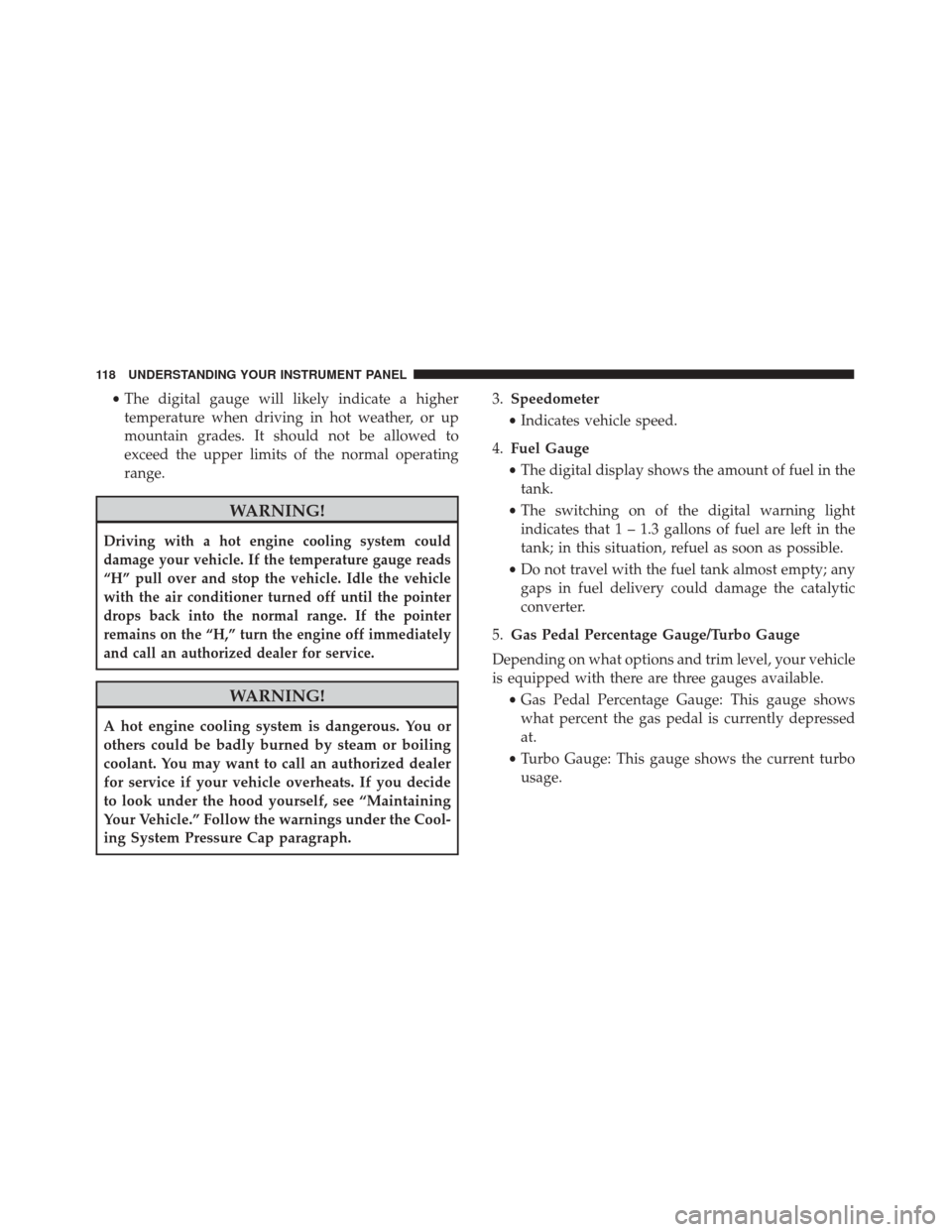
•The digital gauge will likely indicate a higher
temperature when driving in hot weather, or up
mountain grades. It should not be allowed to
exceed the upper limits of the normal operating
range.
WARNING!
Driving with a hot engine cooling system could
damage your vehicle. If the temperature gauge reads
“H” pull over and stop the vehicle. Idle the vehicle
with the air conditioner turned off until the pointer
drops back into the normal range. If the pointer
remains on the “H,” turn the engine off immediately
and call an authorized dealer for service.
WARNING!
A hot engine cooling system is dangerous. You or
others could be badly burned by steam or boiling
coolant. You may want to call an authorized dealer
for service if your vehicle overheats. If you decide
to look under the hood yourself, see “Maintaining
Your Vehicle.” Follow the warnings under the Cool-
ing System Pressure Cap paragraph. 3.
Speedometer
• Indicates vehicle speed.
4. Fuel Gauge
• The digital display shows the amount of fuel in the
tank.
• The switching on of the digital warning light
indicates that 1 – 1.3 gallons of fuel are left in the
tank; in this situation, refuel as soon as possible.
• Do not travel with the fuel tank almost empty; any
gaps in fuel delivery could damage the catalytic
converter.
5. Gas Pedal Percentage Gauge/Turbo Gauge
Depending on what options and trim level, your vehicle
is equipped with there are three gauges available. •Gas Pedal Percentage Gauge: This gauge shows
what percent the gas pedal is currently depressed
at.
• Turbo Gauge: This gauge shows the current turbo
usage.
118 UNDERSTANDING YOUR INSTRUMENT PANEL
Page 126 of 338
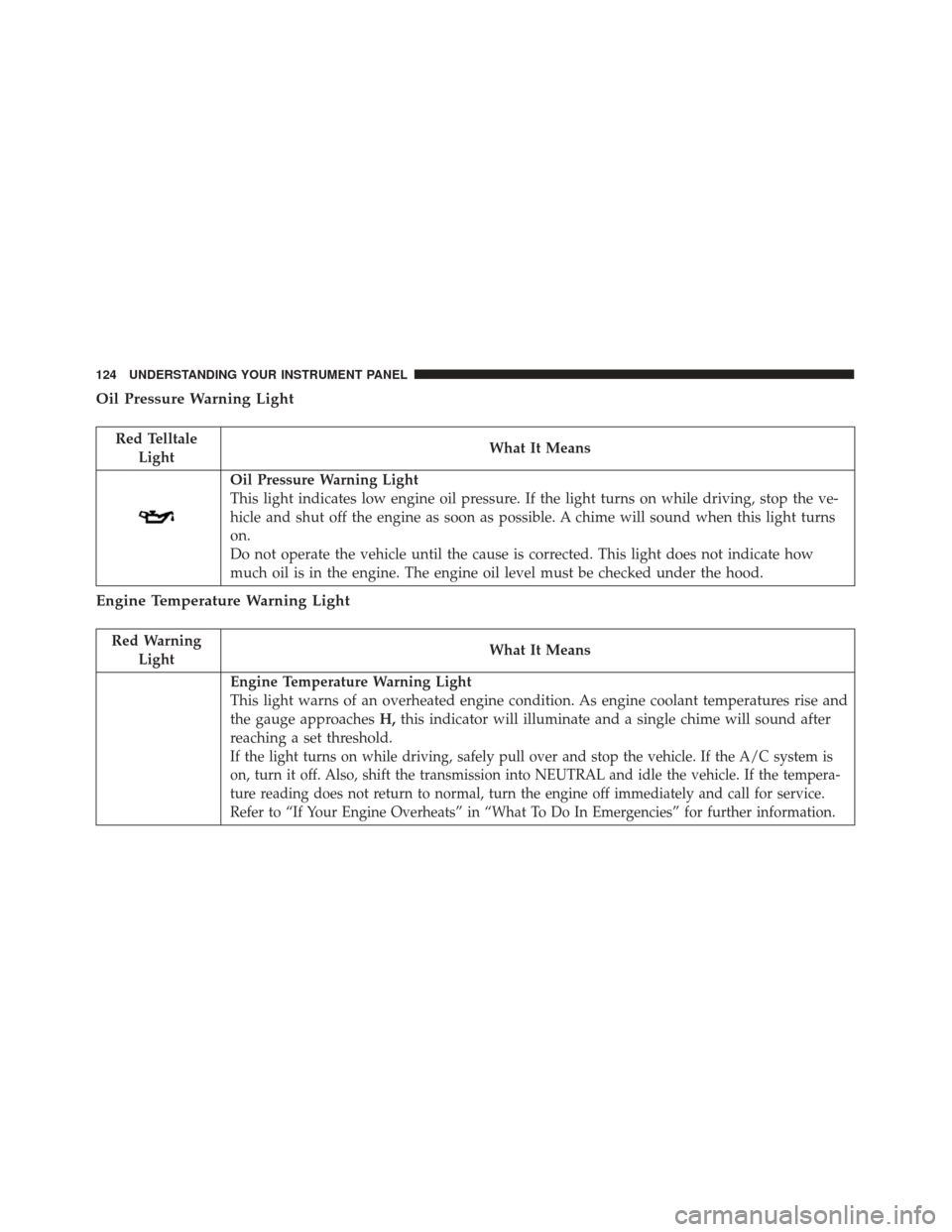
Oil Pressure Warning Light
Red TelltaleLight What It Means
Oil Pressure Warning Light
This light indicates low engine oil pressure. If the light turns on while driving, stop the ve-
hicle and shut off the engine as soon as possible. A chime will sound when this light turns
on.
Do not operate the vehicle until the cause is corrected. This light does not indicate how
much oil is in the engine. The engine oil level must be checked under the hood.
Engine Temperature Warning Light
Red Warning
Light What It Means
Engine Temperature Warning Light
This light warns of an overheated engine condition. As engine coolant temperatures rise and
the gauge approaches
H,this indicator will illuminate and a single chime will sound after
reaching a set threshold.
If the light turns on while driving, safely pull over and stop the vehicle. If the A/C system is
on, turn it off. Also, shift the transmission into NEUTRAL and idle the vehicle. If the tempera-
ture reading does not return to normal, turn the engine off immediately and call for service.
Refer to “If Your Engine Overheats” in “What To Do In Emergencies” for further information.
124 UNDERSTANDING YOUR INSTRUMENT PANEL
Page 196 of 338
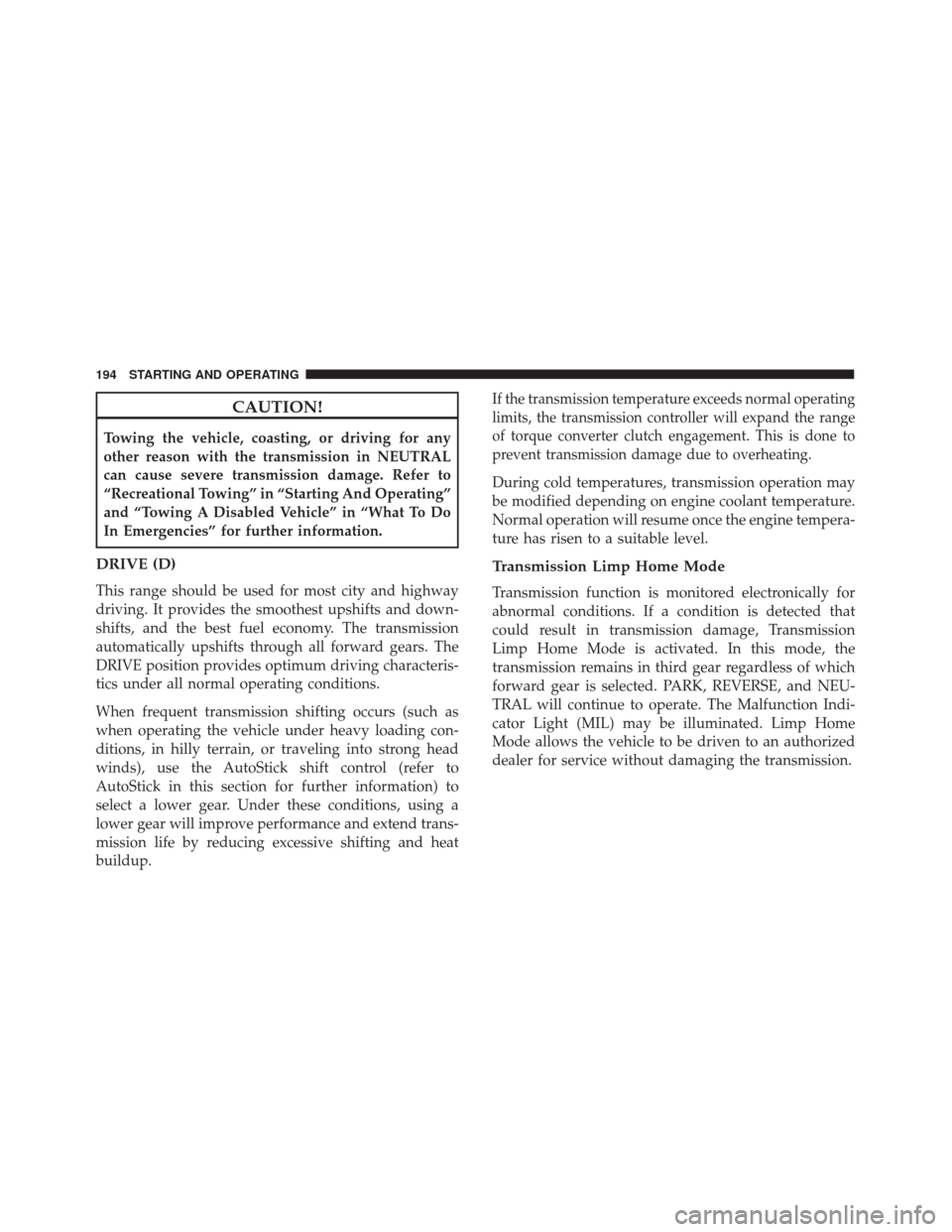
CAUTION!
Towing the vehicle, coasting, or driving for any
other reason with the transmission in NEUTRAL
can cause severe transmission damage. Refer to
“Recreational Towing” in “Starting And Operating”
and “Towing A Disabled Vehicle” in “What To Do
In Emergencies” for further information.
DRIVE (D)
This range should be used for most city and highway
driving. It provides the smoothest upshifts and down-
shifts, and the best fuel economy. The transmission
automatically upshifts through all forward gears. The
DRIVE position provides optimum driving characteris-
tics under all normal operating conditions.
When frequent transmission shifting occurs (such as
when operating the vehicle under heavy loading con-
ditions, in hilly terrain, or traveling into strong head
winds), use the AutoStick shift control (refer to
AutoStick in this section for further information) to
select a lower gear. Under these conditions, using a
lower gear will improve performance and extend trans-
mission life by reducing excessive shifting and heat
buildup.
If the transmission temperature exceeds normal operating
limits, the transmission controller will expand the range
of torque converter clutch engagement. This is done to
prevent transmission damage due to overheating.
During cold temperatures, transmission operation may
be modified depending on engine coolant temperature.
Normal operation will resume once the engine tempera-
ture has risen to a suitable level.
Transmission Limp Home Mode
Transmission function is monitored electronically for
abnormal conditions. If a condition is detected that
could result in transmission damage, Transmission
Limp Home Mode is activated. In this mode, the
transmission remains in third gear regardless of which
forward gear is selected. PARK, REVERSE, and NEU-
TRAL will continue to operate. The Malfunction Indi-
cator Light (MIL) may be illuminated. Limp Home
Mode allows the vehicle to be driven to an authorized
dealer for service without damaging the transmission.
194 STARTING AND OPERATING
Page 285 of 338
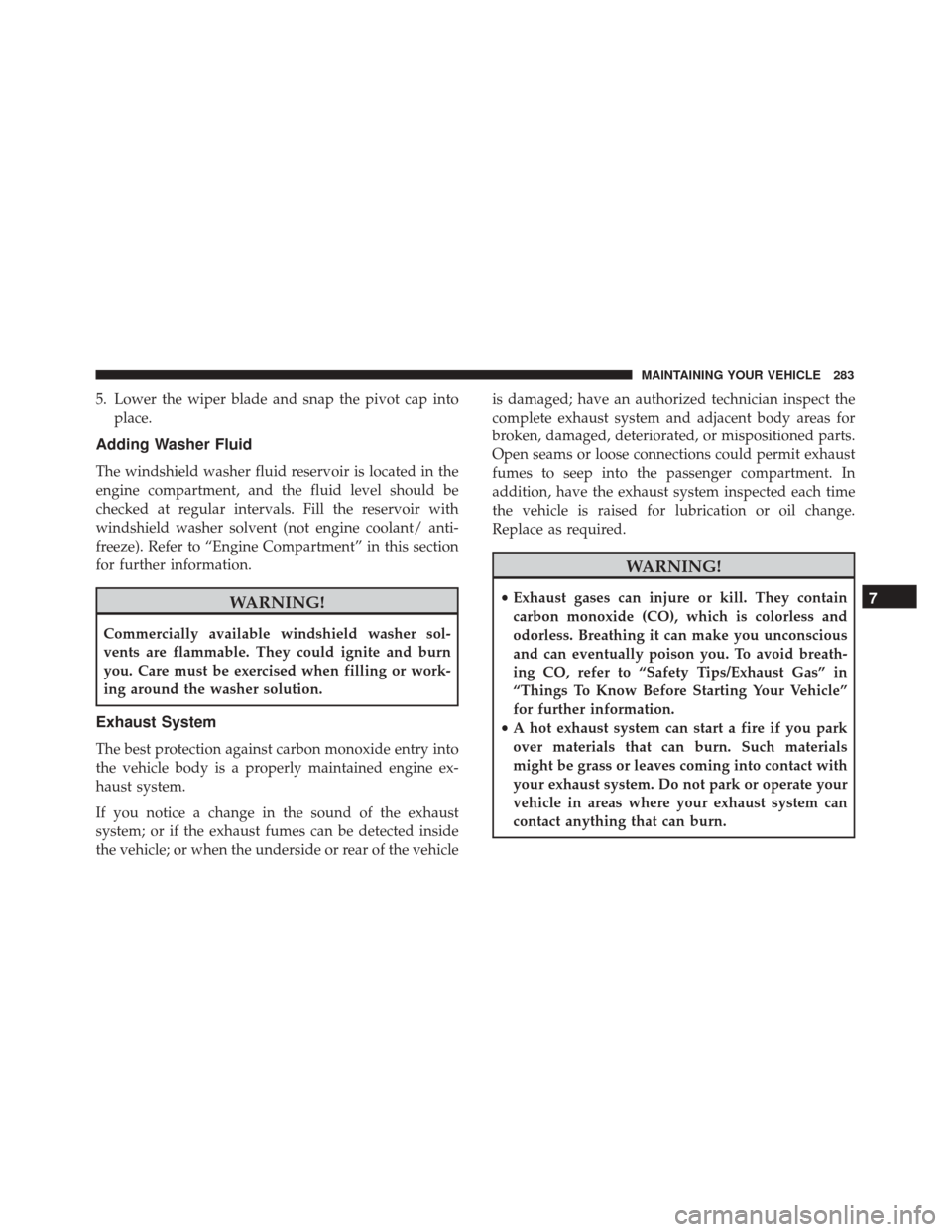
5. Lower the wiper blade and snap the pivot cap intoplace.
Adding Washer Fluid
The windshield washer fluid reservoir is located in the
engine compartment, and the fluid level should be
checked at regular intervals. Fill the reservoir with
windshield washer solvent (not engine coolant/ anti-
freeze). Refer to “Engine Compartment” in this section
for further information.
WARNING!
Commercially available windshield washer sol-
vents are flammable. They could ignite and burn
you. Care must be exercised when filling or work-
ing around the washer solution.
Exhaust System
The best protection against carbon monoxide entry into
the vehicle body is a properly maintained engine ex-
haust system.
If you notice a change in the sound of the exhaust
system; or if the exhaust fumes can be detected inside
the vehicle; or when the underside or rear of the vehicle is damaged; have an authorized technician inspect the
complete exhaust system and adjacent body areas for
broken, damaged, deteriorated, or mispositioned parts.
Open seams or loose connections could permit exhaust
fumes to seep into the passenger compartment. In
addition, have the exhaust system inspected each time
the vehicle is raised for lubrication or oil change.
Replace as required.
WARNING!
•
Exhaust gases can injure or kill. They contain
carbon monoxide (CO), which is colorless and
odorless. Breathing it can make you unconscious
and can eventually poison you. To avoid breath-
ing CO, refer to “Safety Tips/Exhaust Gas” in
“Things To Know Before Starting Your Vehicle”
for further information.
• A hot exhaust system can start a fire if you park
over materials that can burn. Such materials
might be grass or leaves coming into contact with
your exhaust system. Do not park or operate your
vehicle in areas where your exhaust system can
contact anything that can burn.7
MAINTAINING YOUR VEHICLE 283
Page 289 of 338
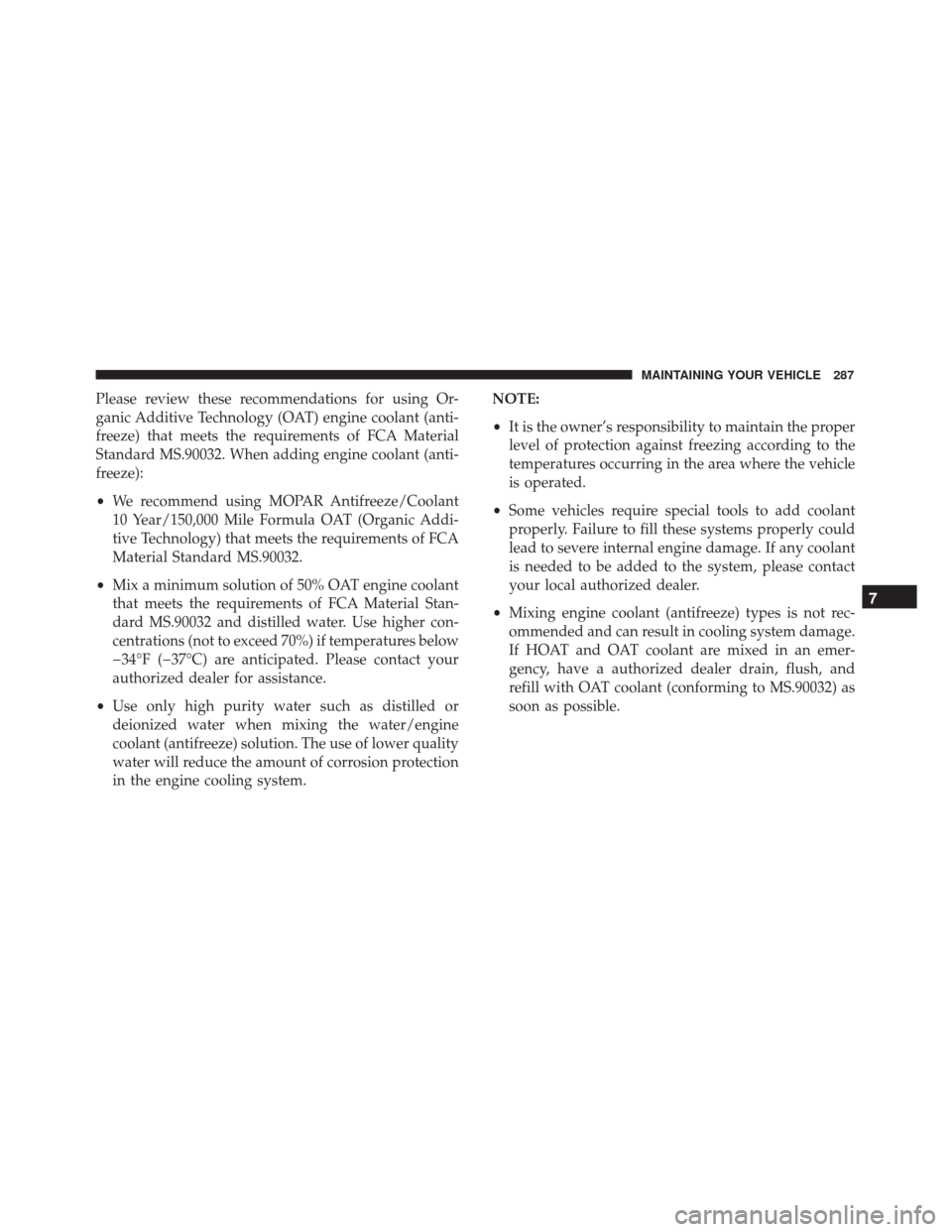
Please review these recommendations for using Or-
ganic Additive Technology (OAT) engine coolant (anti-
freeze) that meets the requirements of FCA Material
Standard MS.90032. When adding engine coolant (anti-
freeze):
•We recommend using MOPAR Antifreeze/Coolant
10 Year/150,000 Mile Formula OAT (Organic Addi-
tive Technology) that meets the requirements of FCA
Material Standard MS.90032.
• Mix a minimum solution of 50% OAT engine coolant
that meets the requirements of FCA Material Stan-
dard MS.90032 and distilled water. Use higher con-
centrations (not to exceed 70%) if temperatures below
�34°F (�37°C) are anticipated. Please contact your
authorized dealer for assistance.
• Use only high purity water such as distilled or
deionized water when mixing the water/engine
coolant (antifreeze) solution. The use of lower quality
water will reduce the amount of corrosion protection
in the engine cooling system. NOTE:
•
It is the owner’s responsibility to maintain the proper
level of protection against freezing according to the
temperatures occurring in the area where the vehicle
is operated.
• Some vehicles require special tools to add coolant
properly. Failure to fill these systems properly could
lead to severe internal engine damage. If any coolant
is needed to be added to the system, please contact
your local authorized dealer.
• Mixing engine coolant (antifreeze) types is not rec-
ommended and can result in cooling system damage.
If HOAT and OAT coolant are mixed in an emer-
gency, have a authorized dealer drain, flush, and
refill with OAT coolant (conforming to MS.90032) as
soon as possible.
7
MAINTAINING YOUR VEHICLE 287
Page 290 of 338
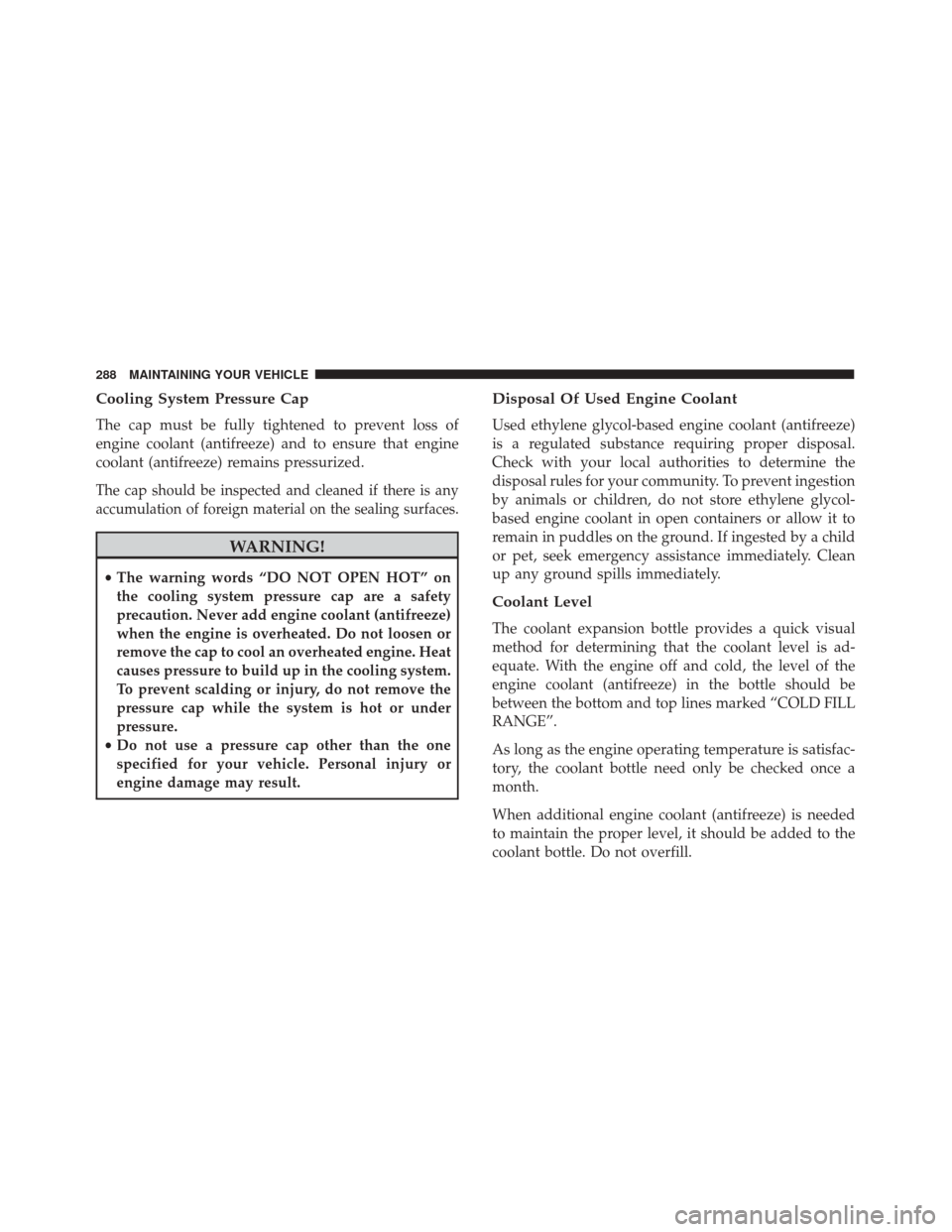
Cooling System Pressure Cap
The cap must be fully tightened to prevent loss of
engine coolant (antifreeze) and to ensure that engine
coolant (antifreeze) remains pressurized.
The cap should be inspected and cleaned if there is any
accumulation of foreign material on the sealing surfaces.
WARNING!
•The warning words “DO NOT OPEN HOT” on
the cooling system pressure cap are a safety
precaution. Never add engine coolant (antifreeze)
when the engine is overheated. Do not loosen or
remove the cap to cool an overheated engine. Heat
causes pressure to build up in the cooling system.
To prevent scalding or injury, do not remove the
pressure cap while the system is hot or under
pressure.
• Do not use a pressure cap other than the one
specified for your vehicle. Personal injury or
engine damage may result.
Disposal Of Used Engine Coolant
Used ethylene glycol-based engine coolant (antifreeze)
is a regulated substance requiring proper disposal.
Check with your local authorities to determine the
disposal rules for your community. To prevent ingestion
by animals or children, do not store ethylene glycol-
based engine coolant in open containers or allow it to
remain in puddles on the ground. If ingested by a child
or pet, seek emergency assistance immediately. Clean
up any ground spills immediately.
Coolant Level
The coolant expansion bottle provides a quick visual
method for determining that the coolant level is ad-
equate. With the engine off and cold, the level of the
engine coolant (antifreeze) in the bottle should be
between the bottom and top lines marked “COLD FILL
RANGE”.
As long as the engine operating temperature is satisfac-
tory, the coolant bottle need only be checked once a
month.
When additional engine coolant (antifreeze) is needed
to maintain the proper level, it should be added to the
coolant bottle. Do not overfill.
288 MAINTAINING YOUR VEHICLE
Page 314 of 338
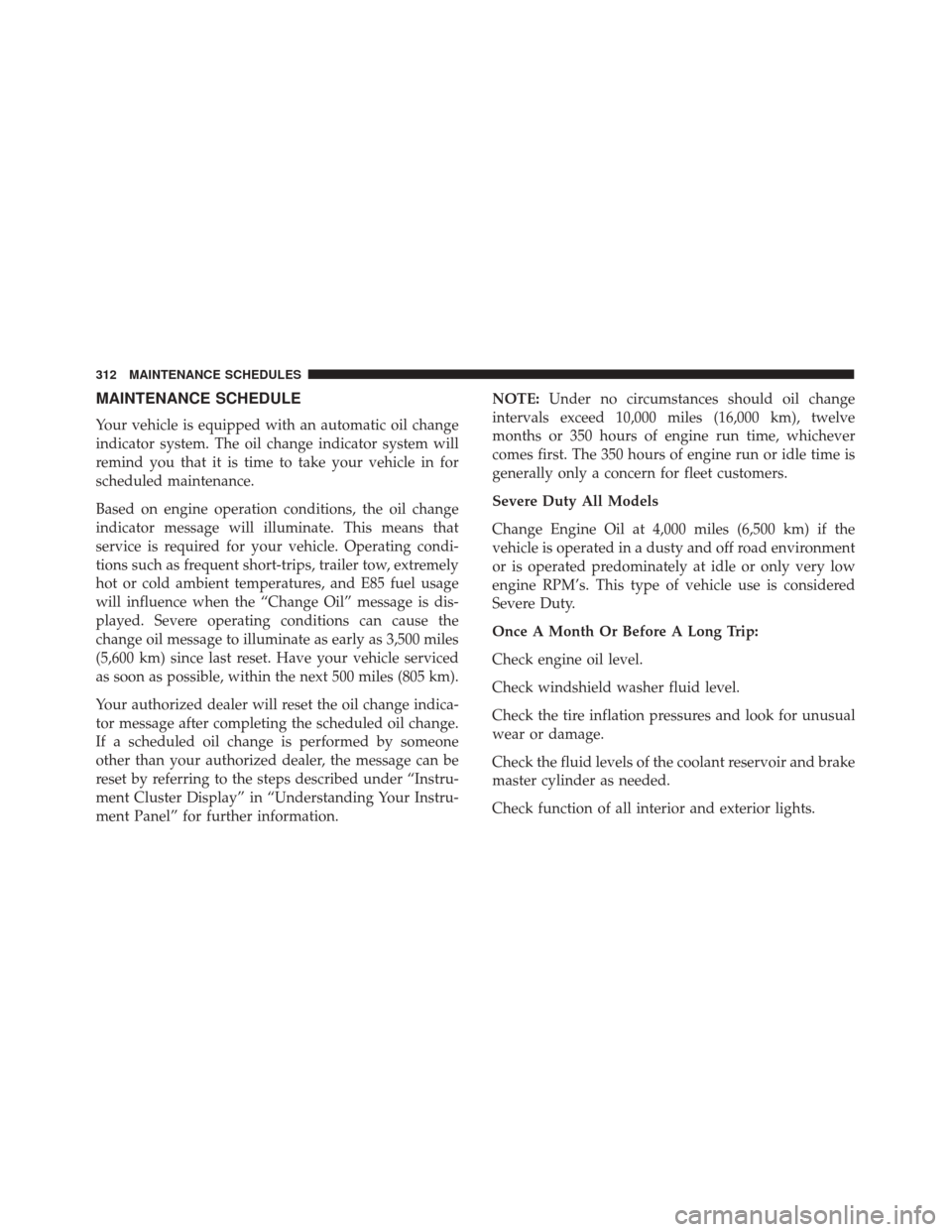
MAINTENANCE SCHEDULE
Your vehicle is equipped with an automatic oil change
indicator system. The oil change indicator system will
remind you that it is time to take your vehicle in for
scheduled maintenance.
Based on engine operation conditions, the oil change
indicator message will illuminate. This means that
service is required for your vehicle. Operating condi-
tions such as frequent short-trips, trailer tow, extremely
hot or cold ambient temperatures, and E85 fuel usage
will influence when the “Change Oil” message is dis-
played. Severe operating conditions can cause the
change oil message to illuminate as early as 3,500 miles
(5,600 km) since last reset. Have your vehicle serviced
as soon as possible, within the next 500 miles (805 km).
Your authorized dealer will reset the oil change indica-
tor message after completing the scheduled oil change.
If a scheduled oil change is performed by someone
other than your authorized dealer, the message can be
reset by referring to the steps described under “Instru-
ment Cluster Display” in “Understanding Your Instru-
ment Panel” for further information.NOTE:
Under no circumstances should oil change
intervals exceed 10,000 miles (16,000 km), twelve
months or 350 hours of engine run time, whichever
comes first. The 350 hours of engine run or idle time is
generally only a concern for fleet customers.
Severe Duty All Models
Change Engine Oil at 4,000 miles (6,500 km) if the
vehicle is operated in a dusty and off road environment
or is operated predominately at idle or only very low
engine RPM’s. This type of vehicle use is considered
Severe Duty.
Once A Month Or Before A Long Trip:
Check engine oil level.
Check windshield washer fluid level.
Check the tire inflation pressures and look for unusual
wear or damage.
Check the fluid levels of the coolant reservoir and brake
master cylinder as needed.
Check function of all interior and exterior lights.
312 MAINTENANCE SCHEDULES
Page 326 of 338
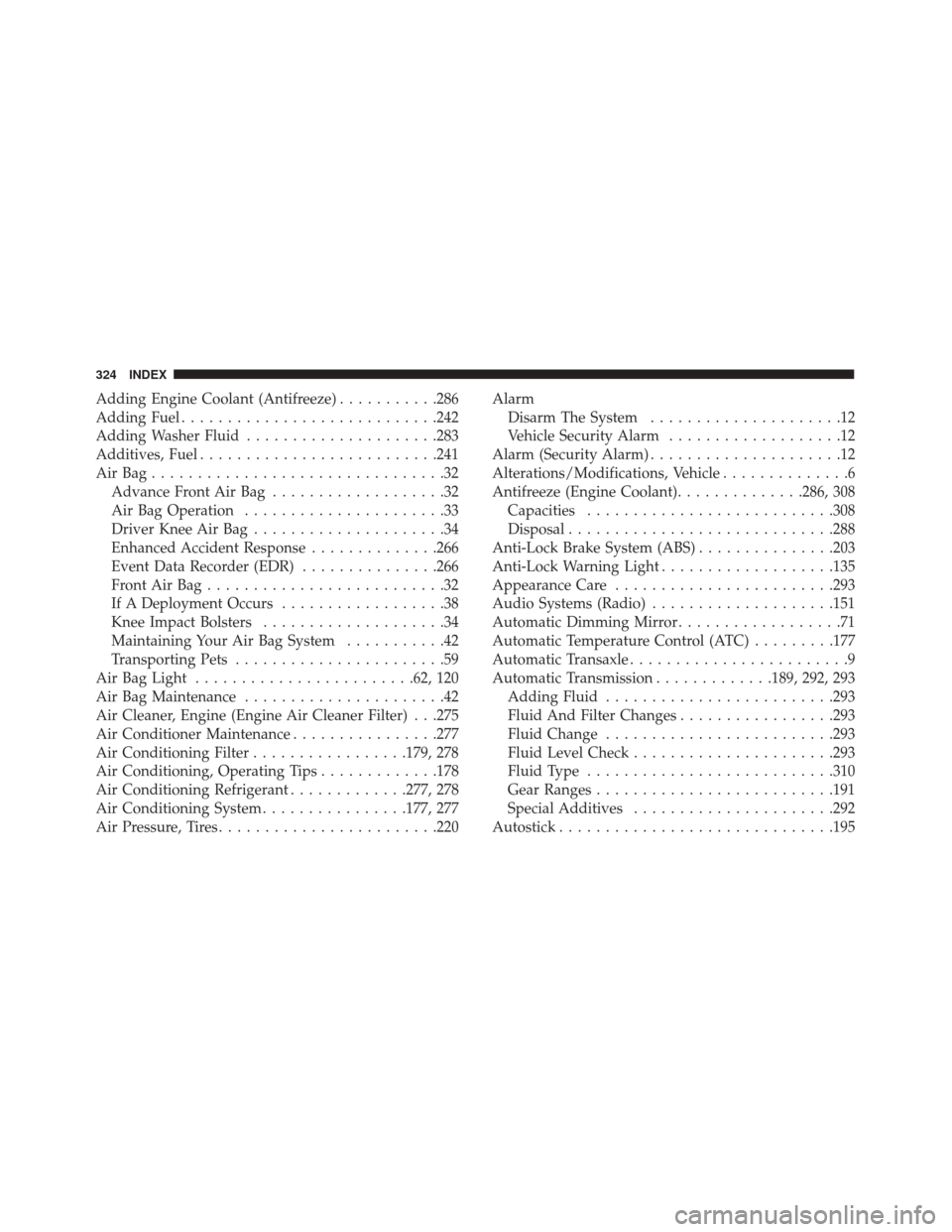
Adding Engine Coolant (Antifreeze)...........286
Adding Fuel ........................... .242
Adding Washer Fluid .....................283
Additives, Fuel ......................... .241
AirBag................................32 Advance Front Air Bag ...................32
Air Bag Operation ......................33
Driver Knee Air Bag .....................34
Enhanced Accident Response ..............266
Event Data Recorder (EDR) ...............266
FrontAirBag..........................32
If A Deployment Occurs ..................38
Knee Impact Bolsters ....................34
Maintaining Your Air Bag System ...........42
Transporting Pets .......................59
Air Bag Light ....................... .62, 120
Air Bag Maintenance ......................42
Air Cleaner, Engine (Engine Air Cleaner Filter) . . .275
Air Conditioner Maintenance ................277
Air Conditioning Filter .................179, 278
Air Conditioning, Operating Tips .............178
Air Conditioning Refrigerant .............277, 278
Air Conditioning System ................177, 277
Air Pressure, Tires ....................... .220Alarm
Disarm The System .....................12
Vehicle Security Alarm ...................12
Alarm (Security Alarm) .....................12
Alterations/Modifications, Vehicle ..............6
Antifreeze (Engine Coolant) ..............286, 308
Capacities .......................... .308
Disposal ............................ .288
Anti-Lock Brake System (ABS) ...............203
Anti-Lock Warning Light ...................135
Appearance Care ....................... .293
Audio Systems (Radio) ....................151
Automatic Dimming Mirror ..................71
Automatic Temperature Control (ATC) .........177
Automatic Transaxle ........................9
Automatic Transmission .............189, 292, 293
Adding Fluid ........................ .293
Fluid And Filter Changes .................293
Fluid
Change ........................ .293
Fluid Level Check ..................... .293
Fluid Type .......................... .310
Gear Ranges ......................... .191
Special Additives ..................... .292
Autostick ............................. .195
324 INDEX
Page 328 of 338
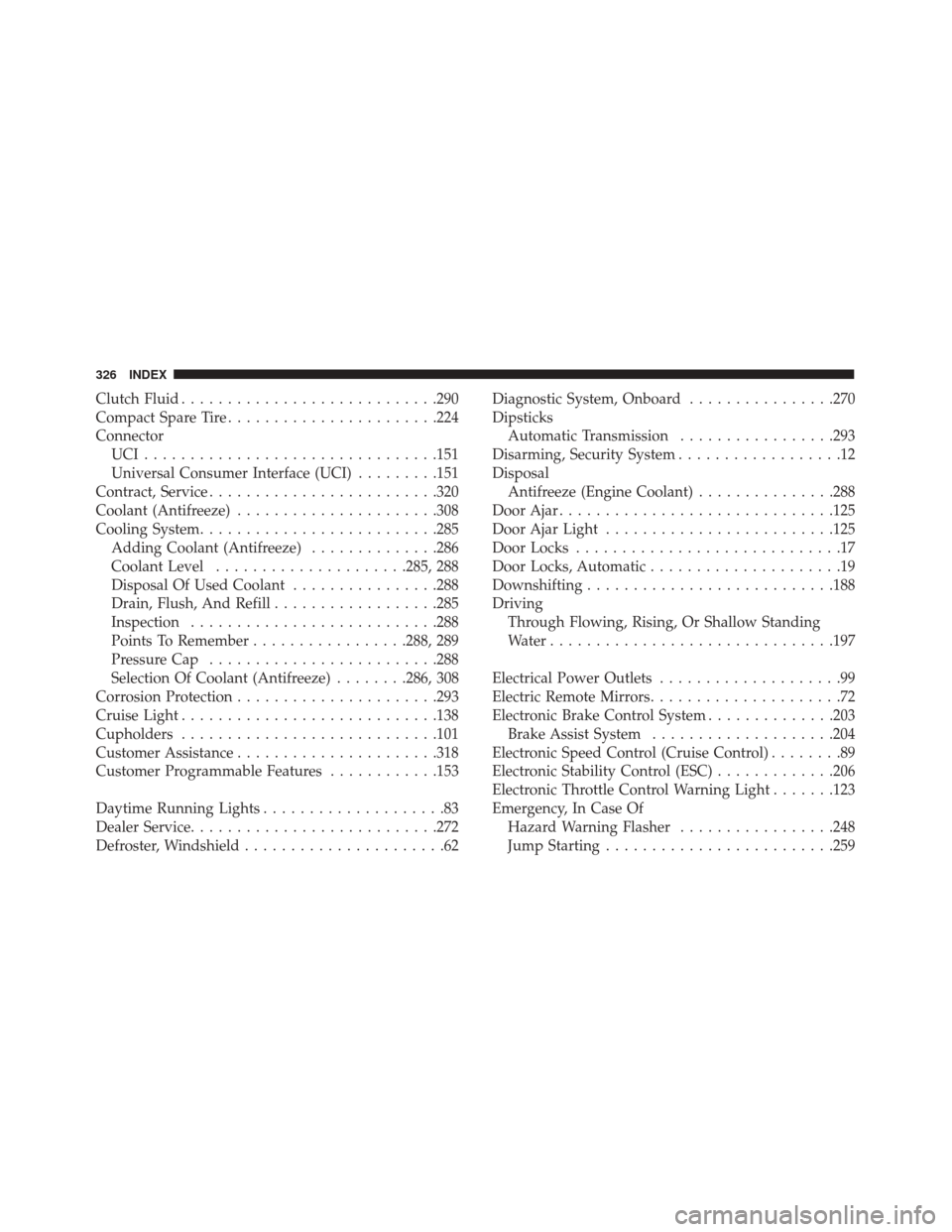
Clutch Fluid........................... .290
Compact Spare Tire ...................... .224
Connector UCI............................... .151
Universal Consumer Interface (UCI) .........151
Contract, Service ........................ .320
Coolant (Antifreeze) ..................... .308
Cooling System ......................... .285
Adding Coolant (Antifreeze) ..............286
Coolant Level .....................285, 288
Disposal Of Used Coolant ................288
Drain, Flush, And Refill ..................285
Inspection .......................... .288
Points To Remember .................288, 289
Pressure Cap ........................ .288
Selection Of Coolant (Antifreeze) ........286, 308
Corrosion Protection ..................... .293
Cruise Light ........................... .138
Cupholders ........................... .101
Customer Assistance ..................... .318
Customer Programmable Features ............153
Daytime Running Lights ....................83
Dealer Service .......................... .272
Defroster, Windshield ......................62 Diagnostic System, Onboard
................270
Dipsticks Automatic Transmission .................293
Disarming, Security System ..................12
Disposal Antifreeze (Engine Coolant) ...............288
Door Ajar ............................. .125
Door Ajar Light ........................ .125
Door Locks .............................17
Door Locks, Automatic .....................19
Downshifting .......................... .188
Driving Through Flowing, Rising, Or Shallow Standing
Water .............................. .197
Electrical Power Outlets ....................99
Electric Remote Mirrors .....................72
Electronic Brake Control System ..............203
Brake
Assist System ....................204
Electronic Speed Control (Cruise Control) ........89
Electronic Stability Control (ESC) .............206
Electronic Throttle Control Warning Light .......123
Emergency, In Case Of Hazard Warning Flasher .................248
Jump Starting ........................ .259
326 INDEX